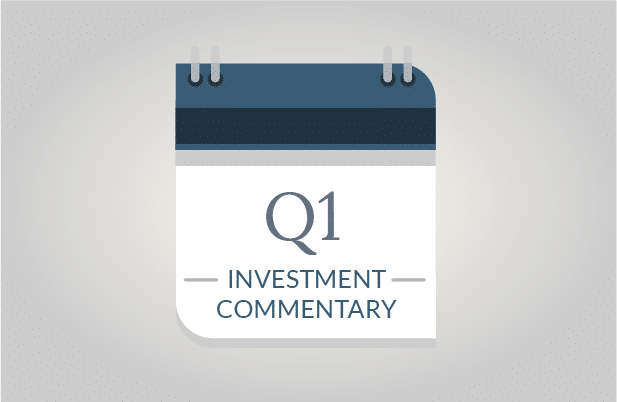SageVest Wealth Management’s latest quarterly commentary is now available. Highlights include:
– The first quarter proved to be one of the strongest in history, following on the heels of a challenging 2018.
– Trade tensions subsided, but haven’t disappeared.
– The yield curve officially inverted, a potentially ominous sign of a recession in the wings.
Up, Up, Up, Not So Fast
The first quarter of the year started off with amazing gusto. Stock markets around the globe soared on the news that major Central Banks were halting interest rate increases and that trade tensions were easing. The first quarter was poised to become one of the most celebrated in history, until it stumbled during the last remaining days as the quarter drew to a close. Global growth again fell into question and the yield curve formally inverted, rendering a potentially cautious outlook for the future.
We have repeatedly advised clients and readers to carefully evaluate their investment positioning to ensure that they’re comfortably situated to enjoy potential market upside exposure, while also protecting for market downside exposure. On the heels of two rather stunning quarters, a tumultuous fourth quarter of 2018, and a skyrocketing first quarter of 2019, we strongly encourage everyone to take careful stock of their investment holdings. We’re not saying that a bear market is on the horizon. In fact, we’ll go into the many reasons why good times could still lie ahead. However, we do think it would be foolish to ignore a significant market warning sign, particularly having experienced a roller coaster fourth quarter and recouping 2018’s losses so quickly in 2019. In our eyes, there’s no better time to reposition if this is appropriate for you.
Fed And Central Bank Pausing
After a series of Federal Reserve rate increases, the Fed paused in raising rates further, offering guidance of an extended pause. This decision related to the emergence of global growth concerns. However, it still came as a bit of a surprise, given the fairly quick change in the Fed’s dialogue and messaging. It’s a further surprise given the fact that our job market is red hot, a possible inflationary warning. A pause by the Federal Reserve and other Central Banks around the world has raised questions about why and what Central Banks are foreseeing, and how much of a global slowdown may be on the horizon.
Yield Curve Inversion
Who says bonds are boring? Yes, they typically don’t provide the lofty returns of stocks. However, they do serve a purpose, offering investors capital preservation options and providing important insights about the economy. Bonds became the big story of the first quarter as rates plummeted, boosting bond values. The first quarter return on the Barclays Aggregate Bond Index was a startling 2.9% which is a colossal quarter move for bonds.
What was more startling, and what became one of the biggest topics in Quarter 1, was an inversion of the yield curve. This is a rare event where long-term yields fall below short-term yields. We saw a partial inversion last year when the belly of the curve inverted. However, on March 22nd, a full inversion occurred. On that same day, the German Bund yield (equivalent to the US Treasury yield) once again fell into negative territory.
What does this mean? It means that the investment markets see a slowdown in economic growth, with long-term inflation pressures lessening, relative to current inflation. It may also mean that a recession’s on the horizon. In fact, seven out of the past nine previous yield curve inversions were followed by an economic recession, whether short- or longer lived. While these might sound like strong odds of a recession looming, it’s not a certainty. Hence, we look further.
Before we delve into what might or might not trigger a recession, it’s important to note two things:
- Recessions typically occur one to two years after an inversion in the yield curve, not immediately thereafter.
- The stock market typically serves as a leading indicator of the economy, meaning that a stock downturn frequently occurs before an economic downturn. We might have already witnessed this in the fourth quarter of 2018.
Concerns Surrounding A Possible Recession
Primary concerns as we look forward include:
- Earnings: We expect corporate earnings to slow in 2019, after likely hitting peaks in 2018 as a result of tax reform.
- Trade Tensions: Trade tensions have waned with ongoing talks between the US and China, but nothing is officially resolved and lingering tariffs are likely. Furthermore, we are now entering an election cycle, which could bring more trade rhetoric on the campaign trail.
- Brexit: What can we say? Brexit is just a mess! No one knows when Britain or other countries will gain trade certainty in a political environment that changes on a dime almost daily. This level of uncertainty is definitively reducing growth.
- Debt Levels: Debt levels are at record highs for both government and corporate debt. While there are different schools of thought about debt, it does tend to stymie growth.
Positives That May Abate A Recession
Before we get too negative, our economy still has a number of positive attributes:
- Strong Economy: While there are distinct concerns about a slowdown in global growth, our domestic economy remains rather robust.
- Strong Job Market: One of the strongest elements of our economy right now is the job market, with incredibly low unemployment levels. Workers are gaining employment and wage traction, helping to pad bank accounts and spending in support of the economy
- 2% Inflation: The Fed’s target inflation rate is 2%, virtually right where current inflation is reading, meaning that we’re in the ‘sweet spot’ for economic growth. We’re growing, but not so fast that the Fed needs to slow growth.
- Accommodative Rates: Despite numerous rate increases by the Fed, rates remain well below historical norms. The 10-year Treasury’s general historical average has been close to 4%, as compared to its current levels in the low-to-mid 2% range. This means that money is still relatively cheap for personal and corporate consumption.
- Fed Tool Belt: Finally, the fact that the Fed has increased rates over the past several quarters means that it’s reclaimed an important tool in its belt; the ability to reduce rates and stimulate growth if needed.
What To Watch Now
Now that a yield curve inversion is official, it’s time to watch and wait, to see if it’s short-lived or if it persists. A short-lived inversion is ideal, helping to lessen future concerns.
Conversely, a persistent inversion would be far more ominous. We’re eager to see economic data points as they become available in the second quarter. We’re curious to see how the tea leaves read, relative to recent Central Bank decisions based on global growth concerns.
Finally, we’re also watching to see if the Fed takes action to help re-stimulate growth. Remember the mantra, “Don’t fight the Fed”. The Fed could in fact have the power to stave off a recession if one becomes a real threat.
Looking Forward
We conclude by reiterating that this is a prudent time to evaluate your investment positioning. We’ve discussed this with clients over the past year, but we’re always happy to engage in further discussions to ensure that you’re comfortable with your holdings.




